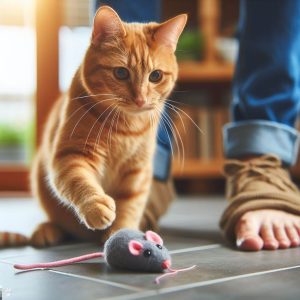It’s common knowledge that cats can have multiple litters in a year. But exactly how many times can a female cat get pregnant annually? The answer largely depends on the reproductive cycle of felines.
Unlike humans, cats do not undergo menopause and can continue reproducing into old age. Cats are polyestrous – meaning they have multiple heat periods each year. This allows fertile cats to mate and conceive multiple times within a 12-month timeframe.
According to veterinarians, on average, a healthy cat will have 3 to 5 estrus cycles per year. With each heat period lasting roughly one week,female cats will demonstrate mating behaviors every 2-3 weeks during peak breeding season.
So a cat that goes into heat 5 times a year could potentially have 5 litters in a single year, with roughly 2 months between pregnancies. Of course, this is a maximum estimate. Factors like age, health, and whether breeding is successful can impact actual numbers.
Understanding how often cats can get pregnant in a year is key to responsible pet ownership. This article will provide an in-depth look at the feline reproductive cycle and tips to prevent unwanted litters. Read on to learn more about the fascinating physiology behind multiple cat pregnancies annually.
An Overview of the Feline Reproductive System
Female cats, known as queens, reach reproductive maturity between 6 to 10 months of age. Their reproductive system includes ovaries, uterus, cervix, and vagina. Queens go through estrus cycles, commonly referred to as “going into heat.”
During this time, ovarian follicles mature and estrogen levels rise, leading to behavioral and physical changes. The queen becomes vocal, restless, rubs against objects, and holds her tail to the side. Her genitals become swollen and she releases pheromones.
The Feline Estrus Cycle
Cats are polyestrous, meaning they go through multiple estrus cycles throughout the year. Here are some key characteristics of the feline estrus cycle:
- Duration: 4-6 days on average
- Frequency: every 2-3 weeks during breeding season
- Season: variable, often spring to fall
- Phases: proestrus, estrus, interestrus, anestrus
The interestrus period lasts 1-2 weeks between cycles. The anestrus phase is a period of reproductive inactivity lasting weeks to months, typically in winter.
How Often Can Cats Mate in a Year?
On average, cats go through 3 to 5 estrus cycles during breeding season. This means a queen can mate multiple times within a year.
Generally, cats do not ovulate or conceive during their first heat cycle. The cycle must conclude before a pregnancy can occur.
With a 2-3 week cycle length, a cat can go into heat as frequently as every 15-20 days. With 3-5 cycles per breeding season, a cat can get pregnant up to 5 times a year.
Typical Feline Pregnancy Timeline
Here is the typical timeline for a 63-65 day feline pregnancy:
- Mating/conception: Eggs fertilized during mating can be viable for up to 7 days.
- Nesting: About 2 weeks after mating, the queen may begin nesting behaviors.
- Morning sickness: Appetite changes and vomiting can occur 3-4 weeks into pregnancy.
- Enlarged nipples: Around 3 weeks, nipples become enlarged and pink.
- Weight gain: Gradual weight gain becomes noticeable around 5 weeks along.
- Movement: Fetal movement can be felt as early as 6 weeks.
- Delivery: Birth typically occurs 63-65 days after conception. Most queens give birth to a litter of 3-5 kittens.
Tips to Prevent Unwanted Litters
It’s best to spay cats before their first heat around 5-6 months old. Here are some tips to prevent unwanted pregnancies:
- Spaying: Sterilization surgery removes the ovaries/uterus. This is over 99% effective at preventing pregnancy.
- Limit roaming: Keep cats indoors or supervised to prevent mating. Escaped cats often get pregnant.
- Separate cats: House male and female cats separately, especially during breeding season.
- Deter mating: Discourage mating behaviors like spraying cats with water or distracting them.
- Vasectomy: Neutering surgery for males prevents pregnancy while maintaining hormones.
- Contraceptives: Temporary options like shots or implants may suppress estrus cycles. Discuss options with your vet.
Signs Your Cat May Be Pregnant
If an accidental mating occurs, watch for these signs of possible pregnancy:
- Decreased appetite in early stage
- Vomiting starting around 3 weeks
- Enlarged, pink nipples around 3 weeks
- Weight gain after 4-5 weeks
- Rounded abdomen in mid-stage
- Mammary gland enlargement
- Increased vocalization
- Behavior changes like affection or aggression
- Nesting behaviors like scratching and meowing
Schedule a vet exam immediately if pregnancy is suspected. Ultrasounds or palpation can confirm. Pregnancy can be safely terminated within the first month. Discuss options like spay/abort surgery or mismating shots. If allowed to proceed, prepare for kitten care.
Caring for a Pregnant or Nursing Cat
If your cat’s pregnancy continues, here are some tips for good prenatal and postnatal care:
- Feed a high-quality kitten formula diet with extra protein and calories
- Give digestive support with foods like bone broth
- Ensure quiet, comfortable nesting areas are available
- Place nesting boxes around the home a week before birth
- Avoid litter box changes 1-2 weeks before delivery
- Monitor weight to meet nutritional needs
- Limit stress and changes to environment/routine
- Discuss supplements like prenatal vitamins with your vet
- Watch for signs of labor like restlessness and panting
- Prepare kitten supplies like food, bedding, litter, toys
- Isolate mom and kittens in a nursery area after birth
- Weigh kittens daily and track nursing and elimination
- Handle kittens gently to avoid stressing mom
- Schedule vet exams for mom at 4-6 weeks post-birth
- Begin socialization and rehoming of kittens at 8-12 weeks old
With preparation and responsible care, a cat can successfully deliver multiple litters. However, preventing pregnancy through early spaying and vigilance is best. Discuss any reproductive or behavioral concerns with your veterinarian.
Frequently Asked Questions
Here are some common questions about cat pregnancy frequency and care:
How many times a year can a cat get pregnant?
With an average estrus cycle every 15-20 days and 3-5 cycles per breeding season, a cat can get pregnant up to 5 times in a single year.
At what age do female cats go into heat?
Most cats reach sexual maturity and begin estrus cycles between 6-10 months of age. However, some cats experience first heat as early as 4 months old.
How often do cats go into heat?
During peak breeding season, cats go into heat every 2-3 weeks. Cycles repeat until pregnancy occurs or seasons change. Some cats have longer interestrus periods of 3-4 weeks between heats.
How long are cats in heat?
A cat’s estrus phase when she is receptive to breeding lasts about 4-6 days on average. Total cycle length between periods of heat is usually 15-20 days.
Can cats get pregnant while nursing?
Yes, it is possible for a nursing cat to get pregnant again within weeks of giving birth if she goes into heat. Lactation does not suppress the estrus cycle long-term.
How can I stop my cat from going into heat?
The only guaranteed ways to stop estrus cycles are spay surgery or suppressive contraceptives. Limiting contact with males, pheromone plugins, exercise, and distraction may temporarily deter behaviors.
Final Tips on Preventing Frequent Feline Pregnancies
- Consult your vet about the right age for spay surgery, around 5-6 months for kittens.
- Schedule appointments for spay, neuter, or vasectomy procedures before first heat.
- Keep cats indoors and away from roaming when in heat.
- Separate female and male cats, especially during breeding months.
- Discourage mating by startling or distracting cats.
- Act quickly if you suspect pregnancy and discuss options with your vet.
- Provide attentive, low-stress care to pregnant and nursing cats.
- Begin socialization and adoption planning for kittens around 8-12 weeks old.
With vigilance and early spaying, it is possible to prevent unwanted cat pregnancies and litters. However, if a surprise pregnancy occurs, consult your vet and prepare to give mom and kittens attentive care. Be a responsible pet owner by learning about feline heat cycles and pregnancy timelines.



